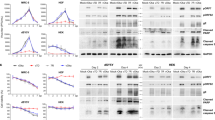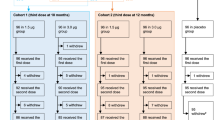Abstract
Wild-type varicella zoster virus (VZV) causes chickenpox, a common childhood illness characterized by fever and a vesicular rash1 and rare serious complications2. Wild-type VZV persists in a latent form in the sensory ganglia, and can re-activate to cause herpes zoster3. More than 10 million American children have received the live attenuated Oka strain VZV vaccine (OkaVZV) since its licensure in 1995. Pre-licensure clinical studies showed that mean serum anti-VZV levels among vaccinees continued to increase with time after vaccination. This was attributed to immunologic boosting caused by exposure to wild-type VZV in the community4,5. Here, we examine the alternative, that large-scale asymptomatic reactivation of OkaVZV might occur in vaccinees. We analyzed serum antibody levels and infection rates for 4 years of follow-up in 4,631 children immunized with OkaVZV. Anti-VZV titers decreased over time in high-responder subjects, but rose in vaccinees with low titers. Among subjects with low anti-VZV titers, the frequency of clinical infection and immunological boosting substantially exceeded the 13%-per-year rate of exposure to wild-type varicella. These findings indicate that OkaVZV persisted in vivo and reactivated as serum antibody titers decreased after vaccination. This has salient consequences for individuals immunized with OkaVZV.
This is a preview of subscription content, access via your institution
Access options
Subscribe to this journal
Receive 12 print issues and online access
$209.00 per year
only $17.42 per issue
Buy this article
- Purchase on Springer Link
- Instant access to full article PDF
Prices may be subject to local taxes which are calculated during checkout

Similar content being viewed by others
References
Cohen, J.I., Brunell, P.A., Straus, S.E. & Krause, P.R. NIH conference: Recent advances in varicella-zoster virus infection. Ann. Intern. Med. 130, 922–932 (1999).
Wharton, M. The epidemiology of varicella-zoster virus infections. Infect. Dis. Clin. North. Am. 10, 571–581 (1996).
Straus, S.E. et al. Endonuclease analysis of viral DNA from varicella and subsequent zoster infections in the same patient. N. Engl. J. Med. 311, 1362–1364 (1984).
Asano, Y., et al Experience and reason: Twenty-year follow-up of protective immunity of the Oka strain live varicella vaccine. Pediatrics 94, 524–526 (1994).
Krause, P.R. & Klinman, D.M. Efficacy, immunogenicity, safety, and use of live attenuated chickenpox vaccine. J. Pediatr. 127, 518–525 (1995).
Weibel, R.E., J, N.B. & Kuter, B.J. Live attenuated varicella vaccine: efficacy trial in healthy children. N. Engl. J. Med. 310, 1409– 1415 (1984).
Kuter, B. et al. Oka/Merck varicella vaccine in healthy children: final report of a 2-year efficacy study and 7-year follow-up studies. Vaccine 9, 643–647 ( 1991).
Choo, P.W., Donahue, J.G., Manson, J.E. & Platt, R. The epidemiology of varicella and its complications. J. Infect. Dis. 172, 706–712 ( 1995).
Finger, R., Hughes, J., Meade, B., Pelletier, A. & Palmer, C. Age-specific incidence of chickenpox. Public Health Rep. 109, 750–755 (1994).
Bernstein, H.H. et al. Clinical survey of natural varicella compared with breakthrough varicella after immunization with live attenuated Oka/Merck varicella vaccine . Pediatrics 92, 833–83 (1993).
Varis, T. & Vesikari, T. Efficacy of high-titer live attenuated varicella vaccine in healthy young children. J. Infect. Di. 174, S330–4 (1996).
Luby, J., Ramirez-Ronda, C., Rinner, S., Hull, A. & Vergne-Marini, P. Alongitudinal study of varicella-zoster virus infections in renal transplant recipients. J. Infect. Dis. 135, 659–663 ( 1977).
Arvin, A., Koropchak, C. & Wittek, A. Immunologic Evidence of re-infection with varicella-zoster virus. J. Infect. Dis. 148, 200– 205 (1983).
Tomita, H., Tanaka, M., Kukimoto, N. & Ikeda, M. An ELISA study on varicella-zoster virus infection in acute peripheral facial palsy. Acta Otolaryngol. (Stockh.) 446, 10– 16 (1988).
Scheiermann, N. & Gesemann, M. Anti-HBs antibody kinetics - A 4 year follow-up after hepatitis B vaccination. Zentralbl. Bakteriol. 278, 120–126 (1993).
Hope-Simpson, R.E. The nature of herpes zoster: a long-term study and a new hypothesis. Proc. R. Soc. Lond. 58, 9–20 (1965).
Ljungman, P. et al. Clinical and subclinical reactivation of varicella-zoster virus in immunocompromised patients. J. Infect. Dis. 153, 840–847 (1986).
Wilson, A., Sharp, M., Koropchak, C.M., Ting, S.F. & Arvin, A.M. Subclinical varicella-zoster virus viremia, herpes zoster, and T lymphocyte immunity to varicella-zoster viral antigens after bone marrow transplantation. J. Infect. Dis. 165, 119–26 (1992).
Merck & Co. in Physician's Desk Reference 52nd edn. 1762–1765 (Medical Economics, Montvale, New Jersey, 1998).
Brunell, P.A., Taylor, J., Geiser, C.F., Frierson, L. & Lydick, E. Risk of herpes zoster in children with leukemia: varicella vaccine compared with history of chickenpox. Pediatrics 77, 53–65 (1986).
Hardy, I., Gershon, A.A., Steinberg, S.P. & LaRussa, P. The incidence of zoster after immunization with live attenuated varicella vaccine. N. Engl. J. Med. 325, 1545– 1550 (1991).
Wasmuth, E.H. & Miller, W.J. Sensitive ELISA for antibody to varicella-zoster virus using purified VZV glycoprotein antigen. J. Med. Virol. 32, 189–193 (1990).
Keller, P.M., Lonergan, K., Neff, B.J., Morton, D.A. & Ellis, R.W. Purification of individual varicella-zoster virus (VZV) glycoproteins gpI, gpII, and gpIII and their use in ELISA for detection of V ZV glycoprotein-specific antibodies. J. Virol. Meth. 14, 177–188 (1986).
Colton, T. in Statistics in Medicine 153–159 (Little, Brown, Boston, 1974).
Acknowledgements
We thank P., Patriarca, A., Rosenberg, F., Steinberg and W., Egan for their critical review of this manuscript. We also thank M. Gesemann for providing raw data from a 4-year follow-up of recipients of hepatitis B vaccine. The assertions herein are the private ones of the authors and are not to be construed as official or as reflecting the views of the Food and Drug Administration.
Author information
Authors and Affiliations
Corresponding author
Rights and permissions
About this article
Cite this article
Krause, P., Klinman, D. Varicella vaccination: Evidence for frequent reactivation of the vaccine strain in healthy children. Nat Med 6, 451–454 (2000). https://doi.org/10.1038/74715
Received:
Accepted:
Issue Date:
DOI: https://doi.org/10.1038/74715
This article is cited by
-
Immune Responses to Varicella-Zoster Virus Glycoprotein E Formulated with Poly(Lactic-co-Glycolic Acid) Nanoparticles and Nucleic Acid Adjuvants in Mice
Virologica Sinica (2021)
-
Varicella-zoster vaccine: The bad news may be good
Nature Medicine (2000)
-
Varicella vaccine revisited
Nature Medicine (2000)
-
Varicella vaccine revisited
Nature Medicine (2000)
-
Reply to “Varicella vaccine revisited“
Nature Medicine (2000)



